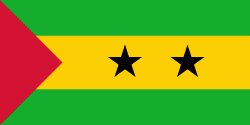Príncipe
Príncipe (in Portuguese is the smaller, northern major island of the country of São Tomé and Príncipe lying off the west coast of Africa in the Gulf of Guinea. It has an area of 142 km² (including offshore islets) and a population of 7,324 at the 2012 Census; the latest official estimate (at May 2018) was 8,420. The island is a heavily eroded volcano speculated to be over three million years old, surrounded by smaller islands including Ilheu Bom Bom, Ilhéu Caroço, Tinhosa Grande and Tinhosa Pequena. Part of the Cameroon Line archipelago, Príncipe rises in the south to 947 metres at Pico do Príncipe. The island is the main constituent of the Autonomous Region of Príncipe, established in 1995, and of the coterminous district of Pagué.
The island was uninhabited when discovered by the Portuguese on 17 January 1471 and was first named after Saint Anthony ("Ilha de Santo Antão"). Later the island was renamed Príncipe ("Prince's [Island]") by King John II of Portugal in honour of his son Afonso, Hereditary Prince of Portugal (1475–1491). The first settlement, the town Santo António, was founded in 1502. Subsequently, the north and centre of the island were made into plantations by Portuguese colonists using slave labor. These concentrated initially on producing sugar and after 1822 on cocoa, becoming the world's greatest cocoa producer. Since independence, these plantations have largely reverted to forest.
The island's fortress named Fortaleza de Santo António da Ponta da Mina on a point inside Baía de Santo António (Santo António Bay) was built in 1695. In 1706, the city and the fortress were destroyed by the French. From 1753 until 1852, Santo António was the colonial capital of Portuguese São Tomé and Príncipe.
Príncipe was the site where Einstein's theory of relativity was experimentally corroborated by Arthur Stanley Eddington and his team during the total solar eclipse of May 29, 1919; photographs of the eclipse revealed evidence of the 'bending' of starlight, in accordance with Einstein's predictions (see Eddington experiment).
On April 29, 1995, the Autonomous Region of Príncipe was established, corresponding with the existing Pagué District.
The island was uninhabited when discovered by the Portuguese on 17 January 1471 and was first named after Saint Anthony ("Ilha de Santo Antão"). Later the island was renamed Príncipe ("Prince's [Island]") by King John II of Portugal in honour of his son Afonso, Hereditary Prince of Portugal (1475–1491). The first settlement, the town Santo António, was founded in 1502. Subsequently, the north and centre of the island were made into plantations by Portuguese colonists using slave labor. These concentrated initially on producing sugar and after 1822 on cocoa, becoming the world's greatest cocoa producer. Since independence, these plantations have largely reverted to forest.
The island's fortress named Fortaleza de Santo António da Ponta da Mina on a point inside Baía de Santo António (Santo António Bay) was built in 1695. In 1706, the city and the fortress were destroyed by the French. From 1753 until 1852, Santo António was the colonial capital of Portuguese São Tomé and Príncipe.
Príncipe was the site where Einstein's theory of relativity was experimentally corroborated by Arthur Stanley Eddington and his team during the total solar eclipse of May 29, 1919; photographs of the eclipse revealed evidence of the 'bending' of starlight, in accordance with Einstein's predictions (see Eddington experiment).
On April 29, 1995, the Autonomous Region of Príncipe was established, corresponding with the existing Pagué District.
Map - Príncipe
Map
Country - São_Tomé_and_Príncipe
 |
 |
It consists of two archipelagos around the two main islands of São Tomé and Príncipe, about 150 km apart and about 250 and 225 km off the northwestern coast of Gabon. With a population of 201,800 (2018 official estimate), São Tomé and Príncipe is the second-smallest and second-least populous African sovereign state after Seychelles.
Currency / Language
| ISO | Language |
|---|---|
| PT | Portuguese language |















